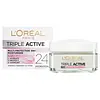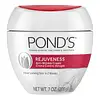What's inside
What's inside
 Key Ingredients
Key Ingredients

 Benefits
Benefits

 Concerns
Concerns

 Ingredients Side-by-side
Ingredients Side-by-side

Water
Skin ConditioningGlycerin
HumectantPentaerythrityl Tetraethylhexanoate
EmollientDimethicone
EmollientButylene Glycol
HumectantButyrospermum Parkii Butter
Skin ConditioningGlyceryl Stearate Se
EmulsifyingPEG-40 Stearate
EmulsifyingCetyl Alcohol
EmollientStearic Acid
CleansingPalmitic Acid
EmollientCamellia Oleifera Seed Oil
Skin ConditioningSorbitan Tristearate
EmulsifyingDimethiconol
EmollientSodium Hydroxide
BufferingPrunus Amygdalus Dulcis Oil
Skin ConditioningDisodium EDTA
Acrylates/C10-30 Alkyl Acrylate Crosspolymer
Emulsion StabilisingTocopherol
AntioxidantPentaerythrityl Tetra-Di-T-Butyl Hydroxyhydrocinnamate
AntioxidantPhenoxyethanol
PreservativeCI 14700
Cosmetic ColorantCI 19140
Cosmetic ColorantWater, Glycerin, Pentaerythrityl Tetraethylhexanoate, Dimethicone, Butylene Glycol, Butyrospermum Parkii Butter, Glyceryl Stearate Se, PEG-40 Stearate, Cetyl Alcohol, Stearic Acid, Palmitic Acid, Camellia Oleifera Seed Oil, Sorbitan Tristearate, Dimethiconol, Sodium Hydroxide, Prunus Amygdalus Dulcis Oil, Disodium EDTA, Acrylates/C10-30 Alkyl Acrylate Crosspolymer, Tocopherol, Pentaerythrityl Tetra-Di-T-Butyl Hydroxyhydrocinnamate, Phenoxyethanol, CI 14700, CI 19140
Water
Skin ConditioningLactic Acid
BufferingGlycerin
HumectantButylene Glycol
HumectantCetyl Alcohol
EmollientIsopropyl Palmitate
EmollientSteareth-21
CleansingDimethicone
EmollientParaffinum Liquidum
EmollientEthylhexyl Methoxycinnamate
UV AbsorberSteareth-2
EmulsifyingPotassium Hydroxide
BufferingStearyl Dimethicone
EmollientStearic Acid
CleansingBorago Officinalis Seed Oil
EmollientMagnesium Aluminum Silicate
AbsorbentPhenoxyethanol
PreservativeHydroxyethyl Acrylate/Sodium Acryloyldimethyl Taurate Copolymer
Emulsion StabilisingParfum
MaskingOctadecene
SolventIsohexadecane
EmollientMethylparaben
PreservativeHydroxyethylcellulose
Emulsion StabilisingDimethiconol
EmollientXanthan Gum
EmulsifyingDisodium EDTA
Tocopheryl Acetate
AntioxidantPropylparaben
PreservativeBenzophenone-3
UV AbsorberPolysorbate 60
EmulsifyingPotassium Carbonate
BufferingSorbitan Isostearate
EmulsifyingSodium Nitrate
SoothingTocopherol
AntioxidantQuartz
AbrasiveAscorbyl Palmitate
AntioxidantDisodium Phosphate
BufferingBHT
AntioxidantPhospholipids
Skin ConditioningSodium Phosphate
BufferingHydrolyzed Collagen
EmollientCholesterol
EmollientCitronellol
PerfumingCitrus Aurantium Peel Oil
Coumarin
PerfumingGeraniol
PerfumingHexyl Cinnamal
PerfumingLimonene
PerfumingLinalool
PerfumingLinalyl Acetate
MaskingTerpineol
MaskingTetramethyl Acetyloctahydronaphthalenes
MaskingCI 77891
Cosmetic ColorantWater, Lactic Acid, Glycerin, Butylene Glycol, Cetyl Alcohol, Isopropyl Palmitate, Steareth-21, Dimethicone, Paraffinum Liquidum, Ethylhexyl Methoxycinnamate, Steareth-2, Potassium Hydroxide, Stearyl Dimethicone, Stearic Acid, Borago Officinalis Seed Oil, Magnesium Aluminum Silicate, Phenoxyethanol, Hydroxyethyl Acrylate/Sodium Acryloyldimethyl Taurate Copolymer, Parfum, Octadecene, Isohexadecane, Methylparaben, Hydroxyethylcellulose, Dimethiconol, Xanthan Gum, Disodium EDTA, Tocopheryl Acetate, Propylparaben, Benzophenone-3, Polysorbate 60, Potassium Carbonate, Sorbitan Isostearate, Sodium Nitrate, Tocopherol, Quartz, Ascorbyl Palmitate, Disodium Phosphate, BHT, Phospholipids, Sodium Phosphate, Hydrolyzed Collagen, Cholesterol, Citronellol, Citrus Aurantium Peel Oil, Coumarin, Geraniol, Hexyl Cinnamal, Limonene, Linalool, Linalyl Acetate, Terpineol, Tetramethyl Acetyloctahydronaphthalenes, CI 77891
 Reviews
Reviews

Ingredients Explained
These ingredients are found in both products.
Ingredients higher up in an ingredient list are typically present in a larger amount.
Butylene Glycol (or BG) is used within cosmetic products for a few different reasons:
Overall, Butylene Glycol is a safe and well-rounded ingredient that works well with other ingredients.
Though this ingredient works well with most skin types, some people with sensitive skin may experience a reaction such as allergic rashes, closed comedones, or itchiness.
Learn more about Butylene GlycolCetyl Alcohol is a fatty alcohol. Fatty Alcohols are most often used as an emollient or to thicken a product.
Its main roles are:
Though it has "alcohol" in the name, it is not related to denatured alcohol or ethyl alcohol.
The FDA allows products labeled "alcohol-free" to have fatty alcohols.
Learn more about Cetyl AlcoholDimethicone is a type of synthetic silicone created from natural materials such as quartz.
What it does:
Dimethicone comes in different viscosities:
Depending on the viscosity, dimethicone has different properties.
Ingredients lists don't always show which type is used, so we recommend reaching out to the brand if you have questions about the viscosity.
This ingredient is unlikely to cause irritation because it does not get absorbed into skin. However, people with silicone allergies should be careful about using this ingredient.
Note: Dimethicone may contribute to pilling. This is because it is not oil or water soluble, so pilling may occur when layered with products. When mixed with heavy oils in a formula, the outcome is also quite greasy.
Learn more about DimethiconeDimethiconol is a silicone that resembles the popular dimethicone. Like other silicones, it is an emollient. Emollients create a thin film on skin to prevent moisture from escaping.
This ingredient helps to create a silky texture and improve spreadability. Due to its high molecular weight and thickness, it is often combined with cyclopentasiloxane.
Disodium EDTA plays a role in making products more stable by aiding other preservatives.
It is a chelating agent, meaning it neutralizes metal ions that may be found in a product.
Disodium EDTA is a salt of edetic acid and is found to be safe in cosmetic ingredients.
Learn more about Disodium EDTAGlycerin is already naturally found in your skin. It helps moisturize and protect your skin.
A study from 2016 found glycerin to be more effective as a humectant than AHAs and hyaluronic acid.
As a humectant, it helps the skin stay hydrated by pulling moisture to your skin. The low molecular weight of glycerin allows it to pull moisture into the deeper layers of your skin.
Hydrated skin improves your skin barrier; Your skin barrier helps protect against irritants and bacteria.
Glycerin has also been found to have antimicrobial and antiviral properties. Due to these properties, glycerin is often used in wound and burn treatments.
In cosmetics, glycerin is usually derived from plants such as soybean or palm. However, it can also be sourced from animals, such as tallow or animal fat.
This ingredient is organic, colorless, odorless, and non-toxic.
Glycerin is the name for this ingredient in American English. British English uses Glycerol/Glycerine.
Learn more about GlycerinPhenoxyethanol is a preservative that has germicide, antimicrobial, and aromatic properties. Studies show that phenoxyethanol can prevent microbial growth. By itself, it has a scent that is similar to that of a rose.
It's often used in formulations along with Caprylyl Glycol to preserve the shelf life of products.
Stearic Acid is a fatty acid. It is an emollient, emulsifier, and texture enhancer.
As an emollient, stearic acid helps soften skin. It aids the skin's protective barrier by preventing water loss. It also provides a gentle cleansing effect without stripping away natural oils.
Stearic acid may also be used to enhance the texture of products. It can add volume and stabilize ingredients such as water and oil. This can help water and oil ingredients from separating.
Sources of stearic acid include animal or vegetable fats/oils such as coconut or shea. It can be naturally found in butter, cocoa butter, shea butter, vegetable fats, and animal tallow.
This ingredient may not be Malassezia folliculitis, or fungal-acne safe.
Learn more about Stearic AcidTocopherol (also known as Vitamin E) is a common antioxidant used to help protect the skin from free-radicals and strengthen the skin barrier. It's also fat soluble - this means our skin is great at absorbing it.
Vitamin E also helps keep your natural skin lipids healthy. Your lipid skin barrier naturally consists of lipids, ceramides, and fatty acids. Vitamin E offers extra protection for your skin’s lipid barrier, keeping your skin healthy and nourished.
Another benefit is a bit of UV protection. Vitamin E helps reduce the damage caused by UVB rays. (It should not replace your sunscreen). Combining it with Vitamin C can decrease sunburned cells and hyperpigmentation after UV exposure.
You might have noticed Vitamin E + C often paired together. This is because it is great at stabilizing Vitamin C. Using the two together helps increase the effectiveness of both ingredients.
There are often claims that Vitamin E can reduce/prevent scarring, but these claims haven't been confirmed by scientific research.
Learn more about TocopherolWater. It's the most common cosmetic ingredient of all. You'll usually see it at the top of ingredient lists, meaning that it makes up the largest part of the product.
So why is it so popular? Water most often acts as a solvent - this means that it helps dissolve other ingredients into the formulation.
You'll also recognize water as that liquid we all need to stay alive. If you see this, drink a glass of water. Stay hydrated!
Learn more about Water